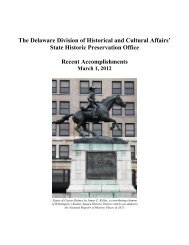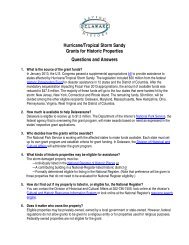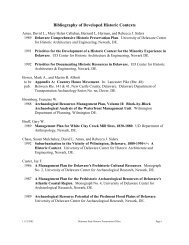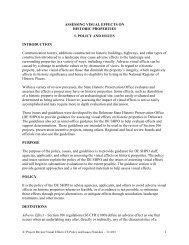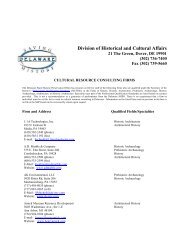Report of the Archaeological Investigations of the New Castle Court ...
Report of the Archaeological Investigations of the New Castle Court ...
Report of the Archaeological Investigations of the New Castle Court ...
You also want an ePaper? Increase the reach of your titles
YUMPU automatically turns print PDFs into web optimized ePapers that Google loves.
NEW CASTLE COURT HOUSE PLAZA<br />
NEW CASTLE, DELAWARE<br />
3.0 FIELD RESULTS<br />
Feature 25<br />
Feature 25 was identified as a concave erosion trench cutting into intact subsoil within EUs 6, 8,<br />
and 26. The lowest fill layer (SU E) appears to cap this feature, which has an overall length <strong>of</strong> 8.4<br />
ft. and <strong>the</strong> depth <strong>of</strong> <strong>the</strong> excavated portion measured 0.32 ft. into <strong>the</strong> surrounding subsoil. A total<br />
<strong>of</strong> 22 artifacts were recovered from <strong>the</strong> sampled portion within EU 8. The assemblage includes<br />
bone and oyster shell fragments, a 7/64th diameter ball clay pipe stem fragment, unidentified<br />
bottle fragments, brick, and window glass fragments. A late seventeenth century occupation may<br />
be inferred from <strong>the</strong> single pipe fragment.<br />
Feature 37<br />
Feature 37 appears to be a concave erosion trench, identified at <strong>the</strong> base <strong>of</strong> Feature 19, within <strong>the</strong><br />
subsoil in EUs 9, 24, and 27 on <strong>the</strong> east plaza (Plate 12). A section was sampled within EUs 9 and<br />
24 and 129 artifacts including a chert flake, bone, clam and oyster shell fragments, ball clay pipe<br />
bowl and stem fragments, brass straight pins, redware, pearlware, white salt-glazed stoneware,<br />
Chinese export porcelain, unidentified bottle glass, an unidentified metal object, cut/wrought nail,<br />
brick and mortar fragment, and window glass were recovered. Based on <strong>the</strong> undecorated<br />
pearlware sherd, a TPQ <strong>of</strong> 1779 was assigned.<br />
3.5.7 MODERN DISTURBANCE<br />
Feature 50<br />
Feature 50 was identified within EU 14 and is located near <strong>the</strong> southwestern corner <strong>of</strong> <strong>the</strong> circa<br />
1732 section. This poured concrete footer, similar in morphology to Feature 6, which was<br />
identified during <strong>the</strong> 1995 DSM fieldwork, cuts through <strong>the</strong> circa 1820 foundation sand and<br />
measures 1.05 by 0.65 ft. in plan. Eleven artifacts were collected from <strong>the</strong> fill deposit overlying<br />
this feature and recovered items include a brass button, one redware sherd, two cut/wrought nails,<br />
and seven fragments <strong>of</strong> window glass. As previously mentioned, this feature appears to mirror<br />
Feature 6 and was dated by <strong>the</strong> DSM to <strong>the</strong> ca. 1955 restoration.<br />
Features 94 and 95<br />
Feature 94 represents an earlier flagpole foundation partially overlain by Feature 95, <strong>the</strong><br />
foundation for <strong>the</strong> existing flagpole. Both are constructed <strong>of</strong> concrete with <strong>the</strong> flagpole set within<br />
<strong>the</strong> center. The earlier foundation was identified after <strong>the</strong> east plaza foundation material was<br />
removed. No artifacts were found in association with ei<strong>the</strong>r feature.<br />
3.5.8 POSSIBLE PALISADE TRENCHES<br />
Three features were documented within <strong>the</strong> exposed sections <strong>of</strong> <strong>the</strong> excavated plaza that are likely<br />
<strong>the</strong> remnants <strong>of</strong> palisade trenches. Two <strong>of</strong> <strong>the</strong>se trenches, Features 24/29 and 27/45, extend<br />
parallel with <strong>the</strong> sou<strong>the</strong>rn façade <strong>of</strong> <strong>the</strong> <strong>Court</strong> House, while <strong>the</strong> third trench, Feature 39, is<br />
orientated perpendicularly along <strong>the</strong> east side. No artifacts were recovered from <strong>the</strong> sectioned<br />
portions which may indicate <strong>the</strong> early nature <strong>of</strong> <strong>the</strong>se features. Supporting this notion is <strong>the</strong> fact<br />
that every o<strong>the</strong>r documented feature was intrusive into this feature category.<br />
Features 24 and 29<br />
Features 24 and 29 represent <strong>the</strong> sou<strong>the</strong>rn palisade trench, which has an east-west orientation and<br />
extends nearly <strong>the</strong> full length <strong>of</strong> <strong>the</strong> circa 1820 plaza. The western edge <strong>of</strong> <strong>the</strong> trench begins at <strong>the</strong><br />
eastern side <strong>of</strong> <strong>the</strong> brick wall, Feature 58, on <strong>the</strong> western plaza and it appears to terminate within<br />
EU 28 on <strong>the</strong> east plaza for a total feature length <strong>of</strong> approximately 73.5 ft. (Figures 5 and 6; Plate<br />
13). It is unclear, however, if this point constitutes <strong>the</strong> eastern edge, or simply where it was<br />
45





